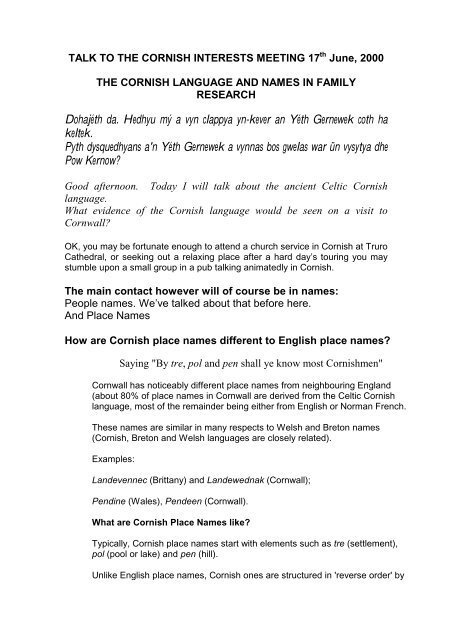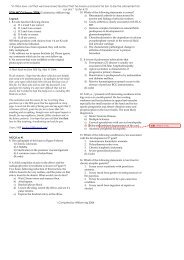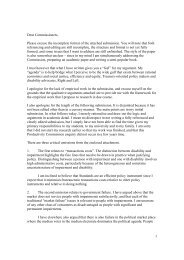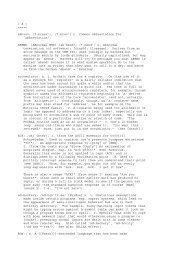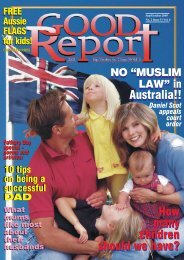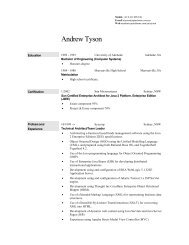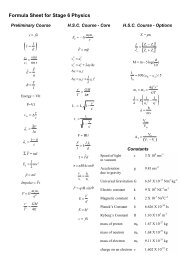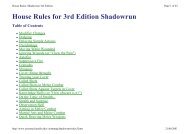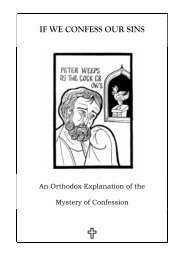Cornish Language & Names in Family Research
Cornish Language & Names in Family Research
Cornish Language & Names in Family Research
- No tags were found...
Create successful ePaper yourself
Turn your PDF publications into a flip-book with our unique Google optimized e-Paper software.
TALK TO THE CORNISH INTERESTS MEETING 17 th June, 2000THE CORNISH LANGUAGE AND NAMES IN FAMILYRESEARCHDohajéth da. Hedhyu mý a vyn clappya yn-kever an Yéth Gernewek coth hakeltek.Pyth dysquedhyans a'n Yéth Gernewek a vynnas bos gwelas war ün vysytya dhePow Kernow?Good afternoon. Today I will talk about the ancient Celtic <strong>Cornish</strong>language.What evidence of the <strong>Cornish</strong> language would be seen on a visit toCornwall?OK, you may be fortunate enough to attend a church service <strong>in</strong> <strong>Cornish</strong> at TruroCathedral, or seek<strong>in</strong>g out a relax<strong>in</strong>g place after a hard day’s tour<strong>in</strong>g you maystumble upon a small group <strong>in</strong> a pub talk<strong>in</strong>g animatedly <strong>in</strong> <strong>Cornish</strong>.The ma<strong>in</strong> contact however will of course be <strong>in</strong> names:People names. We’ve talked about that before here.And Place <strong>Names</strong>How are <strong>Cornish</strong> place names different to English place names?Say<strong>in</strong>g "By tre, pol and pen shall ye know most <strong>Cornish</strong>men"Cornwall has noticeably different place names from neighbour<strong>in</strong>g England(about 80% of place names <strong>in</strong> Cornwall are derived from the Celtic <strong>Cornish</strong>language, most of the rema<strong>in</strong>der be<strong>in</strong>g either from English or Norman French.These names are similar <strong>in</strong> many respects to Welsh and Breton names(<strong>Cornish</strong>, Breton and Welsh languages are closely related).Examples:Landevennec (Brittany) and Landewednak (Cornwall);Pend<strong>in</strong>e (Wales), Pendeen (Cornwall).What are <strong>Cornish</strong> Place <strong>Names</strong> like?Typically, <strong>Cornish</strong> place names start with elements such as tre (settlement),pol (pool or lake) and pen (hill).Unlike English place names, <strong>Cornish</strong> ones are structured <strong>in</strong> 'reverse order' by
comparison with English place names. Therefore Cunebris' settlement wouldbe Tre (settlement) + Conebris = Tregonebris.Also unlike English place names, frequently the first letter of the second partis softened. Note, the change from C to G after Tre <strong>in</strong> the previous example.This is called lenition or a soft mutation . Soft mutations occur mostly afterfem<strong>in</strong><strong>in</strong>e names and th<strong>in</strong>gs.The follow<strong>in</strong>g table shows common <strong>Cornish</strong> words found <strong>in</strong> place names, andthe type of change that follows. Sometimes <strong>in</strong> place names the changes are'irregular' (they do not follow the rules).Table of Some Common Place Name ElementsA few common place name elements are provided below. These are given as aguide onlyElement Gender Mean<strong>in</strong>g MutationTypeExamplesBal M M<strong>in</strong>e None Baldhu (Baldue 1748)Bos, Bo,BodF Dwell<strong>in</strong>g Soft Bosavern (Bosavarn 1302),Botallack (Botalec 1262)Carn M Hill with a rocky None Carn Brea (Carnbree 1348)crownCastel M Castle, fort None Castle-an-D<strong>in</strong>as (Castel-an-dynas1504), Castallack (1284)Chy M House, build<strong>in</strong>g None Chy-an-dour (Chyendower 1504)Eglos F Church, Soft** Eglos Hayle (Eglosheil 1210)M<strong>in</strong>ster-churchLan F ChurchyardenclosureSoftMadron Churchtown (Landythy1616), Gulval Churchtown(Lanystly 1328)Marhas F Market Soft Marazion (Marghasyou 1210;Marcasbyghan 1310)Nans, Nan M Valley None** Nancledra (Nanscludri 1302;Nancledry)Pen F Hill, head Soft Pendeen (Pendyn 1306),Penhalvean (Penhalvyhan 1319)Pol M Lake, pool None Polbathick (Polbarthek 1365)Pons M Bridge None Ponsanooth (Pons-an-Oeth 1521)Porth M Cove, Port None* Porthmeor (Porthmur 1313),Mawganporth (Porthmawgan1755)Ros F Moorland,heath,promontarySoft Rosemullion (Rosmylian 1318),Roseworthy (Roswori 1289)Tre F Settlement Soft Tregonetha (Tregenhetha 1341),Trema<strong>in</strong>e (Tremen 1230)* Some words such as Porth (port or cove) and Nans (valley), can harden the first letter of theword that follows: e.g. Porthpean (Porth Bean or Little Port).** Some words such as Eglos and Forth do not soften the first letter of the word that follows
under some circumstances as expected. E.g. Eglos Boryan (St Buryan's Church).Descriptive Words<strong>Cornish</strong> Word EnglishEquivalentGwyn (wyn, Whitewen, widden)TypicalExamplesPorthgwiddenDu (dhu, zu) Black BaldhuGlas (glaze,laze, las)Green (oldusage), BluePolglazeHyr (heere) Long, tall MenheereBean, Vean(Byghan)SmallPorthpeanWartha, Upper, HigherawarthaWoles (wollas) LowerPredannackWarthaPredannackWollasLesnewthNoweth, Newth NewCoth (coath) Old DolcoathBras (brawze) Large, Big CreegbrawseMur (meor, GreatPorthmeormeere)Sa<strong>in</strong>ts and Place <strong>Names</strong>When a place name <strong>in</strong> Cornwall starts with 'Sa<strong>in</strong>t', this is frequently the English formof the name. The <strong>Cornish</strong> equivalent tends not to use 'Sa<strong>in</strong>t'. In addition, placenames us<strong>in</strong>g just the sa<strong>in</strong>t's name without 'Sa<strong>in</strong>t' on the front tend to commemorate<strong>Cornish</strong> sa<strong>in</strong>ts. Examples <strong>in</strong>clude: Breage (Breaca), Paul (Pol-de-Leon), Germoe,Gwithian, Gw<strong>in</strong>ear.Sa<strong>in</strong>ts names are also often found <strong>in</strong> <strong>Cornish</strong> place names with Lan and Tre(Landythy - St Ita, Lanuste - St Just, Trethewey – poss. Dewy or St David.English <strong>Names</strong> with sa<strong>in</strong>ts and their <strong>Cornish</strong> equivalents:English<strong>Cornish</strong>Sa<strong>in</strong>t Austell Austol (1150)Sa<strong>in</strong>t BuryanEglos Boryan (EglosBerrie 1086) Buryan'sChurchSa<strong>in</strong>t DennisProb. DunmeliocSa<strong>in</strong>t EnoderEglos Enoder(Heglosenuder 1086)Enoder's ChurchSa<strong>in</strong>t Erth Lanuthno (1269)Uthnoe's ChurchSa<strong>in</strong>t Ives Porth Ya (Porthia 1291)Ya's PortSa<strong>in</strong>t Just (Penwith) Lanust (Lanuste 1396)Just's Church
Books on the Subject of <strong>Cornish</strong> Place <strong>Names</strong>A fuller list can be obta<strong>in</strong>ed from the follow<strong>in</strong>g books, which are considered to be reliablesources:o Padel, O.J., A Popular Dictionary of <strong>Cornish</strong> Place <strong>Names</strong>, Alison Hodge, 1988,(ISBN 0-906720-15-X)o Pool, P.A.S., The Place-<strong>Names</strong> of West Penwith, Penzance, 1985o Pool, P.A.S., The Field-<strong>Names</strong> of West Penwith, Penzance, 1990o Weatherhill, C., <strong>Cornish</strong> Place <strong>Names</strong> and <strong>Language</strong>, Sigma Books, 1995, (ISBN 1-85058-462-1)Written and presented by: Chris Dunkerley 17 th June, 2001
David Annear’sLessons <strong>in</strong> Spoken <strong>Cornish</strong>Lesson 1 -- PronunciationThis is a short and approximate guide to <strong>Cornish</strong> pronunciation, which thankfully isn'tas complicated as Irish Gaelic!The lessons will be presented <strong>in</strong> the Kemmyn spell<strong>in</strong>g. Bear <strong>in</strong> m<strong>in</strong>d that this form isusually easiest for beg<strong>in</strong>ners <strong>in</strong> that, like Welsh, the letter-groups are pronouncedexactly the same way <strong>in</strong> every word ... so once you have learnt the sounds of <strong>Cornish</strong>,they are easily applied to the written language. Some spell<strong>in</strong>gs that occur <strong>in</strong> Englishhave many different sounds, (such as "rough, cough, bough, through, though"), but thisconfusion cannot occur <strong>in</strong> <strong>Cornish</strong> -- each group of letters has only one sound. Onceyou are familiar with these simple rules, you will be able to pronounce EVERY <strong>Cornish</strong>word that you see!<strong>Cornish</strong> AlphabetFirst, the alphabet. <strong>Cornish</strong> uses 23 letters from the Roman alphabet. There are nodiacritics of any k<strong>in</strong>d. The 'Ch' group is usually considered as one letter <strong>in</strong> the Kemmynspell<strong>in</strong>g -- that's because 'C' does not occur alone.A B Ch D E F G H I J K L M N O P R S T U V W YPunctuation marks <strong>in</strong> written <strong>Cornish</strong> are as <strong>in</strong> English.PronunciationWords are usually stressed on the penultimate syllable, the last but one. e.g."gorthybow" (answers) is pronounced "gor-THIB-oh" Where this rule is broken (veryrarely), I shall show the stress.Letters are pronounced as <strong>in</strong> English, except for:A as <strong>in</strong> "bat" when followed by a doubled consonant, e.g. "dannvon" (to send). More as<strong>in</strong> "father" but not quite so long when stressed, e.g. the first syllable of "bara" (bread). Aneutral vowel as <strong>in</strong> "the" (not "thee") when unstressed e.g. <strong>in</strong> the second syllable of"bara" (bread).AW to rhyme with "how", e.g."glaw" (ra<strong>in</strong>).AY to rhyme with "by", e.g. "chayn" (cha<strong>in</strong>) is not pronounced as English "cha<strong>in</strong>" butrather like "ch<strong>in</strong>e".C only used when followed by H. K is used for the normal "hard C" sound.DH normally as TH <strong>in</strong> English "this" - not as <strong>in</strong> "th<strong>in</strong>".
E when followed by a doubled consonant or <strong>in</strong> an unstressed syllable, the sound is as <strong>in</strong>English "bet" e.g. "penn" (head), "tiek" (farmer). When followed by a s<strong>in</strong>gle consonantor stressed it has the same sound but lengthened as <strong>in</strong> French "tête", "frêne". This isNOT the same as the vowel sound <strong>in</strong> English "made" or the French "E acute".EU as <strong>in</strong> English "purr" or more accurately as <strong>in</strong> French "peur", e.g. "beudhi" (todrown).EW approximately as <strong>in</strong> English "cow" as said <strong>in</strong> some parts of Cornwall, or moreaccurately as Welsh "tew". Try to say the sound of E <strong>in</strong> "bet" followed immediately bythe vowel sound <strong>in</strong> "boot". <strong>Cornish</strong> people can usually make this sound more easily thanEnglish people.EY as <strong>in</strong> English "veil", e.g. "bleydh" (wolf).G as <strong>in</strong> English "get" (never as <strong>in</strong> "giant").GH sounds as CH <strong>in</strong> Scottish "loch" or German "achtung". The English speaker canachieve this sound by heavily breath<strong>in</strong>g an H sound, but unlike H <strong>in</strong> English, the<strong>Cornish</strong> GH comes <strong>in</strong> the middle or at the end of words and so can be slightly unnaturalfor the English speaker, e.g. "yeghes" (health).I as EE <strong>in</strong> English "beet", e.g. "gwir" (true).IW as English EW <strong>in</strong> "dew", e.g. "niwl" (mist).O normally as the vowel sound <strong>in</strong> English "bought", but as <strong>in</strong> "pot" when followed by adoubled consonant, e.g. "lost" (tail) as <strong>in</strong> "bought", "bronn" (hill) as <strong>in</strong> "pot".OE very approximately a cross between English "toe" and "saw". More accurately asfrench "eau", e.g. "boes" (food).OU as <strong>in</strong> English "boot", e.g. "gour" (husband).OW as <strong>in</strong> "grow" NOT as <strong>in</strong> "cow", e.g. "down" (deep).R should ALWAYS be sounded, i.e. rolled <strong>in</strong> words like "kar" (friend).U usually pronounced as <strong>in</strong> French "tu". It is a cross between English "ee" and "oo" andis notoriously difficult for English speakers. Sometimes used by Scottish speakers ofEnglish say<strong>in</strong>g "you", e.g. "tus" (men, people).Y when found at the end of a word or between consonants (i.e. not with another vowel)the sound is as I <strong>in</strong> "bit" e.g. "bys" (world). When followed by a vowel the sound is as<strong>in</strong> English, e.g. "redya" (to read).YW as English EW <strong>in</strong> "dew", but not as <strong>in</strong> English "you".
Lessons <strong>in</strong> Spoken <strong>Cornish</strong>Lesson 2 -- Greet<strong>in</strong>gs and PhrasesPyth yw dha hanow?What is your name?Peder ov, ha ty?I'm Peter, and you?Jori yw ow hanow vy.My name is George.Lowena dhis, Jori!Goodbye, George!(lit. "happ<strong>in</strong>ess to you")Dyw genes, Peder!Goodbye, Peter!(lit. "God with you")Dydh da!Hello!(lit. "good day")Fatla genes?How are you?(lit. "how goes it with you")Yn poynt da, meur ras.Very well, thank you.Ha genes jy?And you?(lit. "and with you")Summary of words usedda -- gooddha -- yourdhis -- to youdydh -- dayDyw -- Godgenes -- with youha(g) -- andhanow -- nameJori -- Georgelowena -- joy/happ<strong>in</strong>essmeur ras -- many thanks(thankyou)ov -- IamGrammatical po<strong>in</strong>ts• Adjectives usually follow nouns. This isopposite to English, where the adjectiveprecedes the noun. For example, "Good Day"<strong>in</strong> English is "Dydh Da" <strong>in</strong> <strong>Cornish</strong>.• Note that there is no <strong>Cornish</strong> word for "a" or"an", as <strong>in</strong> English "an apple", or "a woman".In <strong>Cornish</strong>, and most Celtic languages, thenoun is used alone; so that "hanow" can mean"name" or "a name".• "Ha" turns <strong>in</strong>to "hag" if the <strong>in</strong>itial letter of thefollow<strong>in</strong>g word is a vowel
ow -- myPeder -- Peterpyth? -- what?ty -- you (s<strong>in</strong>gular)yn -- <strong>in</strong>yw -- isfollow<strong>in</strong>g word is a vowel.• Like many languages other than English,there are two forms for the word "you"."Genes" ("with you") and "ty" ("you") are<strong>in</strong>formal terms usually used with friends andchildren. Slightly more formal terms, andones used with groups of people, are"genowgh", and "hwi".Lessons <strong>in</strong> Spoken <strong>Cornish</strong>Lesson 3 -- Are You ...?Affirmative AnswersOsta ser-prenn?Are you a carpenter?Ov! Ser-prenn ov vy.Yes! I am a carpenter.Osta yeyn?Are you cold?Ov, pur yeyn ov vy!Yes, I'm very cold!Negative AnswersOwgh hwi glyb?Are you wet?On! Glyb on ni!Yes! We're wet!Yw aval?Is it an apple?Nag yw! Bara yw!No! It's bread!Osta gwithyas-kres?Are you a policeman?Nag ov, tiek ov vy.No, I'm a farmer.Owgh hwi dewbries?Are you a couple? Nag on,teylu on!No, we're a family!
Summary of wordsusedaval -- applebara -- breaddewbries -- marriedcoupleglyb -- wetgwithyas-kres --policemanhwi -- you (plural)na(g) -- "not" (seegrammatical)ni -- weon -- we areos (-ta) -- you are(s<strong>in</strong>gular)owgh -- you are(plural)pur -- veryser-prenn -- carpenterteylu -- familytiek -- farmeryeyn -- coldGrammatical po<strong>in</strong>ts• In the sense of answer<strong>in</strong>g questions, thereare no words for "Yes" and "No" <strong>in</strong><strong>Cornish</strong>. The usual practice is to repeatthe verb used <strong>in</strong> the question (<strong>in</strong> therelevant tense); so that the answer to"Osta lowen?" ("Are you happy?") wouldbe either "Ov" ("I am") or "Nag ov" ("Iam not").• The verb for "you are" is really "os". The"-ta" is a suffix which emphasises the"you", and is normally used <strong>in</strong> the "areyou ...?" type of question.• Plac<strong>in</strong>g a verb at the beg<strong>in</strong>n<strong>in</strong>g of asentence turns that sentence <strong>in</strong>to aquestion; e.g. "osta tiek?" ("are you afarmer?"), but "tiek os" ("you are afarmer").• A verb is negated by preced<strong>in</strong>g it with"na". "Na" is a verbal particle - a wordwhich has no real mean<strong>in</strong>g on its own,and is only used before a verb. Note that"na" becomes "nag" if it precedes an<strong>in</strong>itial vowel; e.g. "na vydh" ("he will notbe"), but "nag os" ("you are not").


